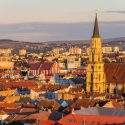Technological evolution is no longer a slow and steady march, it’s a surge, redefining entire industries with unprecedented speed. Among the most impactful developments is the fusion of the Internet of Things (IoT) with cloud computing, a combination that’s unlocking new levels of intelligence, automation, and efficiency.
Transportation and manufacturing, two traditionally complex and resource-intensive sectors, are rapidly embracing this integration. From predictive maintenance of heavy machinery to real-time fleet tracking across continents, the union of IoT and cloud services is reshaping what’s possible. Understanding how this synergy operates, and more importantly, how it delivers measurable value, is essential for any company aiming to thrive in a digital-first economy.
Understanding the Synergy - IoT Meets the Cloud
IoT devices are designed to gather data from the physical world, tracking temperature, motion, usage patterns, location, and more. Yet on their own, these devices are limited in storage, processing power, and long-term analysis. Cloud computing complements this by offering scalable infrastructure, powerful analytics, and centralized platforms that can aggregate, process, and visualize massive volumes of data in real time.
Together, IoT and cloud enable a fully connected ecosystem where devices constantly communicate insights, while cloud platforms synthesize these inputs into actionable intelligence. This creates a feedback loop of learning, adapting, and optimizing, ideal for industries with moving parts, logistical complexity, and high operational stakes.
Smart Transportation - Enhancing Mobility with Intelligence
Modern transportation systems are under pressure to become faster, greener, and more efficient. Whether it’s public transit authorities, logistics companies, or autonomous vehicle developers, the integration of IoT and cloud technology is redefining how transportation is managed and optimized.
Fleet Management and Logistics Optimization
One of the most prominent use cases is in fleet management. Trucks, vans, and cargo vehicles now come equipped with IoT sensors that monitor engine health, fuel consumption, tire pressure, and driving behavior. These sensors transmit data in real time to cloud platforms, where it’s analyzed to detect anomalies, suggest route changes, or flag maintenance needs before issues escalate.
This not only reduces fuel costs and downtime but also improves driver safety and ensures regulatory compliance. Logistics companies can optimize delivery schedules using predictive models, reducing idle times and improving customer satisfaction.
Real-Time Traffic and Route Intelligence
IoT-enabled traffic systems, when linked to cloud platforms, provide dynamic routing information based on live traffic conditions, weather data, and even road construction updates. Navigation apps powered by this data can redirect drivers to faster routes, reducing congestion and emissions across urban areas.
In smart cities, cloud-integrated traffic signals adjust in real time based on vehicular and pedestrian flow, optimizing mobility and emergency response times. Municipal planners use the historical data stored in the cloud to plan infrastructure improvements and forecast future transportation needs with precision.
Public Transit Transformation
Public transportation networks are also leveraging IoT-cloud integration to enhance service delivery. Real-time tracking of buses and trains allows transit authorities to provide accurate arrival times, monitor passenger volumes, and quickly respond to delays or malfunctions. Cloud-based dashboards help operations teams visualize and act on this data instantly, improving overall system reliability and efficiency.
Smart Manufacturing - Driving Efficiency and Innovation
Manufacturing has always been a hotbed for automation, but the integration of IoT and cloud computing is elevating this to a new level, introducing what’s often referred to as Industry 4.0. Factories today are becoming intelligent, adaptive systems capable of self-optimization and real-time decision-making.
Predictive Maintenance and Asset Monitoring
Unplanned equipment failures can be catastrophic for manufacturers, resulting in lost production time, costly repairs, and missed delivery deadlines. IoT sensors embedded in machinery continuously monitor vibrations, temperature, usage hours, and energy consumption. This data is streamed to cloud platforms that use AI and machine learning to detect early signs of wear and predict when a component is likely to fail.
By scheduling maintenance proactively, manufacturers reduce unplanned downtime, extend equipment life, and lower maintenance costs. This shift from reactive to predictive maintenance is only possible through the combined power of IoT sensing and cloud-based analytics.
Digital Twins and Real-Time Production Insights
A digital twin is a virtual replica of a physical asset or system, updated in real time via IoT data and hosted on the cloud. Manufacturers use digital twins to simulate production processes, test different configurations, and monitor performance without disrupting operations.
For example, if a machine on the factory floor begins operating outside of ideal parameters, the digital twin flags the deviation and suggests corrective action. Over time, these models improve through machine learning, continuously optimizing production flows, resource allocation, and quality control.
Supply Chain Visibility and Automation
IoT and cloud integration doesn’t stop at the factory door, it extends across the entire supply chain. Smart sensors on inventory items track location, condition (like temperature for perishables), and delivery status. This data is fed to cloud systems that provide end-to-end visibility, enabling manufacturers to respond quickly to supply disruptions or demand fluctuations.
Automated systems can reorder materials when stocks run low, reroute shipments to avoid delays, and generate detailed reports for compliance and auditing, all with minimal human intervention. This level of agility and transparency is critical in an increasingly globalized and volatile market.
Security and Scalability - Addressing the Core Challenges
As with any transformative technology, the integration of IoT and cloud introduces its own challenges, particularly around security and scalability. With billions of connected devices transmitting sensitive data, ensuring secure communication, authentication, and data storage is non-negotiable.
Leading cloud providers offer robust security frameworks, including end-to-end encryption, identity management, and compliance with international standards. However, businesses must still implement strong internal policies, conduct regular audits, and ensure that IoT devices are not the weak link in their infrastructure.
Scalability is another key concern. As IoT deployments grow from hundreds to millions of devices, cloud platforms must be able to ingest, process, and analyze data without latency or service disruption. Fortunately, modern cloud architectures, such as serverless computing and edge processing, are designed to scale dynamically, ensuring that performance keeps pace with demand.
Looking Ahead - A Future Built on Connectivity
The integration of IoT with cloud computing is still in its early chapters, yet its impact is already substantial. Transportation and manufacturing sectors, long defined by physical assets and manual operations, are now becoming data-centric, intelligent, and hyper-connected.
Emerging technologies such as 5G, AI, and edge computing will further accelerate this transformation. With ultra-low latency and massive device density, 5G will enhance real-time IoT communication. Artificial intelligence will bring deeper predictive capabilities, and edge computing will allow for localized processing when immediate action is required, especially critical for autonomous vehicles and high-speed production lines.
The future belongs to those who not only adopt these technologies but integrate them strategically to drive innovation, resilience, and sustainable growth.
Conclusion
IoT and cloud computing are more than just technological tools, they are catalysts for industry-wide reinvention. In transportation, they enable smarter, safer, and greener mobility. In manufacturing, they unlock new levels of precision, agility, and productivity. Together, they form a foundation for intelligent systems that learn, adapt, and optimize continuously. Companies that embrace this integration stand to gain a competitive edge, not just through efficiency gains, but by creating new value for customers and stakeholders. As industries face growing pressure to modernize and meet rising expectations, the fusion of IoT and cloud isn’t just a smart move—it’s an essential one.



